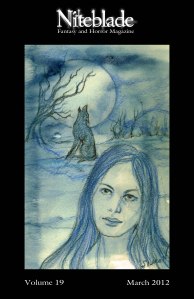Niteblade Volume #19
-Reviewed by Tori Truslow–
Niteblade is an e-zine of fantasy and horror, published by Rhonda Parrish, which sets out to deliver, in the words of its submission guidelines: “unusual, high quality work that uses language and form to deliver content that will make our hearts miss a beat.” This, its 19th issue, was my first try, and while I would not describe every piece as unusual or high quality, the best ones did fulfil those criteria and will stay with me.
The issue’s fiction is an eclectic selection, varied in style and quality, with a couple of gems. A stand-out story is K.V. Taylor’s ‘The Silver Quarter’, a lively adventure centred around a teen boy and girl in a Mediterranean-flavoured fantasy city, both seemingly trapped in the sex trade until they help each other escape. This story eschews the gratuitous grim darkness that seems so beloved of epic fantasy in the Game of Thrones vein; it’s necessarily gritty but doesn’t wallow in it, instead focusing on its characters’ resourcefulness and friendship. Told through the eyes of the boy, Elanzah, who prostitutes himself to a solider in exchange for sword lessons and the empty promise of one day being allowed to join the city’s Elite force, the story manages just the right balance of worldliness and naïveté, shifting in a few sentences from starry-eyed lines like “he smelled like sweat and tobacco. Like falling in love” to the matter-of-fact acknowledgement that “fancy serallos and pimps were better money, but no kind of protection.” This one zings with colour and energy, and is a nice antidote to the gloomy machismo so often found in its genre.
Another strong piece is ‘Three Great Loyalties’ by Lindsey Duncan, which presents an intriguing scene: the wedding of a sorcerer’s daughter to the ghost of a prince, all told through the eyes of the wedding band. At heart it is a story about the complications of marriage when love and politics are at odds, but it certainly comes at the scenario from a novel angle, and I wanted to know more about this world and its rituals. I also liked the way music was used as a narrative device: the observing musicians deliberately use their instruments to soothe or exaggerate tension as events play out.
Nicki Vardon’s ‘Forbidden Fruit’ deserves a mention for its sumptuous language, and for doing an animal point of view well. The narrator is a witch’s cat, whose asides are great fun: “Seventeen years ago my mistress wished for a daughter, so she fed the tree a bullfinch’s heart and ensnared a husband with the harvest. I never heard him complain. Such a waste of a good songbird.” However, despite the rich descriptions of food – “She reaps her orchard to bake tendersweet cherry pies, plucks a pheasant for the spitroast, breaks leaves for smoky tea on the stove” – and striking sexual imagery – “They are quaint creatures, melting into one, sharing each breath, black and ashen hair entwined” – the story could have used a little more meat on its bones, and the ending feels rushed.
The horror pieces have an old-school pulpy feel, which is no bad thing in itself, but for the most part these attempts to marry the colourful, the creepy, and the gruesome – all tied off with the obligatory twist ending – don’t produce anything particularly interesting. A lowlight is Terence Kuch’s ‘Alice’, in which a woman is left by her latest commitment-phobic partner with a “Robo-Doll”, which desperately wants to be loved and, inexplicably, cannot be turned off. She ends up locking it in a cupboard and running off to “the mysterious orient”. The doll, again inexplicably, turns out to be flesh; it dies and decays, the end. ‘Careful what you wish for’ stories are often tiresome, and this one – with its implication that the woman is a terrible person for not wanting an irritating robot baby – especially so.
Of the ‘freaky happenings’ type stories, Wayne Faust’s ‘It Was Limbruner’ is the best: the tale of a photo booth that shows people their future, written in a believably obsessive voice that eventually shows the narrator up for the creep he is.
The poetry is also mixed: Sonya Taaffe’s ‘The Coast Guard’ takes flotsam and jetsam and swells them into mythic forms, conjuring “a ferryman for strand-flung souls / in the tarry seaweed heaps, a salt-stained / and steel-rimmed and cable-knit oracle”. Its rhythm captures the seashore’s “hish and rattle”, and the strangeness of the sea, gorgeously. Far less to my taste was ‘A Hellbound Tragicomedy’ by Stephanie Smith, a poem filled with screams, laughing demons and “ribbons of blood”, with no apparent crafting of sound or metre beyond some irregular rhymes.
A longer piece, Dan Campbell’s ‘The Wake of March’ is an interesting one, presenting an eerie agrarian land where “there is something wrong with the year”. It contains frequent echoes of The Waste Land – soil, storms, cocks crowing, crickets, strangers on the road – but is a more cohesive poem than Eliot’s, something that tripped me up on the first reading, as the allusions to something so famously fragmentary seemed to be at odds with its linear thrust. Further readings are rewarding, however, with lingering images like fields “all red with churning, with our offering / winnowed out over the empty acres” hinting at a bloody fertility ritual narrative; the Waste Land (and, by extension, Golden Bough) allusions come into their own, then.
 Who is Niteblade for? Judging by the contents of this issue (although other issues may well have a different balance), it will be enjoyed either by those with very catholic tastes, or fans of traditional horror motifs and imagery, while individual stories and poems might stand out to fans of other styles and fantasy/horror subgenres; personally, I found it a mixed bag with some pleasant surprises.
Who is Niteblade for? Judging by the contents of this issue (although other issues may well have a different balance), it will be enjoyed either by those with very catholic tastes, or fans of traditional horror motifs and imagery, while individual stories and poems might stand out to fans of other styles and fantasy/horror subgenres; personally, I found it a mixed bag with some pleasant surprises.



